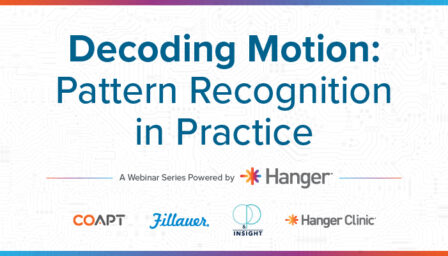Comprehensive Care of Plagiocephaly, Torticollis, and Early Childhood Development

Date and Time
Location
Virtual Event – Hanger Clinic University
Cost: Free
CE Contact Hours: 1.0 CE hours
To receive CE credit and a completion certificate, you must attend the live virtual session and successfully pass a quiz with an 80% or higher. The quiz will be available in Hanger Clinic University to enrolled learners after the webinar.
Hanger Clinic is accredited to provide continuing education credit through a variety of accrediting bodies and provider programs throughout the country for our therapy, nurse, and case manager partners where applicable. Specific course accreditation status information can be found on the course page in Hanger Clinic University.
Please note: Registration in Hanger Clinic University is for external healthcare professionals only. Hanger Employees should access EmpowerED for all of their educational needs and will have access to all webinars in the employee portal following live sessions.
About This Course
Understanding plagiocephaly, torticollis, and early childhood development is essential for physical therapists working with infants and young children. Early identification and intervention can significantly impact a child’s long-term motor development, posture, and overall well-being. Without proper assessment and treatment, these conditions can lead to asymmetries, delayed milestones, and challenges in later development. By deepening their knowledge of head shape assessment, motor milestone progression, and the role of helmet therapy, physical therapists can play a crucial role in guiding families toward the best care decisions and improving patient outcomes.
Participants will explore head shape assessment techniques, motor milestone evaluation, and clinical decision-making for helmet therapy. Through evidence-based strategies, case studies, and hands-on guidance, therapists will gain the skills needed to identify, assess, and treat these conditions effectively. The course also emphasizes interdisciplinary collaboration and parent education to ensure comprehensive care and optimal outcomes for young patients.
Target Audience: Physical and occupational therapists, nurses, case managers, O&P clinicians, and others who care for this patient population
Objectives
Upon completion of this program, learners will be able to:
- Assess cranial asymmetries and motor development milestones to identify plagiocephaly and torticollis in infants.
- Develop individualized treatment plans that incorporate therapeutic interventions, positioning strategies and helmet therapy.
- Educate parents and caregivers on best practices for early intervention, home exercises, and the importance of follow-up care to support optimal child development.
- Describe current evidence that is helping to shape care for relevant patient populations.
Hanger Clinic University Registration and Course Enrollment
Register in Hanger Clinic University and enroll in this course now! Please follow this two step process to ensure your registration and enrollment are complete.
- To attend this Hanger Institute Virtual Classroom course, confirm that you are registered in Hanger Clinic University (HCU). New HCU learners can register here.
- Once your HCU account is established, click here to enroll in the course.
Please note: Registration in Hanger Clinic University is for external healthcare professionals only. Hanger Employees should access EmpowerED for all of their educational needs and will have access to all webinars in the employee portal following live sessions.
To learn more about Hanger Clinic University, visit the HCU Webpage.
Speakers

Shannon O’Shea, CPO
National Clinical Specialist, Pediatrics
Shannon is an ABC-certified prosthetist/orthotist, Area Clinic Manager, and National Clinical Specialist, Pediatrics for Hanger Clinic. She specializes in cranial remolding for infants with plagiocephaly and craniosynostosis and treating idiopathic and neuromuscular scoliosis.

Courtney Graham, PT, DPT
Clinical Director, Carolina Kinder Development
Courtney is a licensed physical therapist and is the clinical director at Carolina Kinder Development. She has received continuing education in Myofascial Release, torticollis, cranial band, Neurodevelopmental Treatment, infant massage and state regulation, Anat-Baniel and postural mechanics, and more.

Stacy Conder, PT
Senior Therapist, Carolina Kinder Development
Stacy has been a licensed physical therapist since 2000.She has extensive continuing education and training in areas including torticollis, Myofascial Release (MFR), cranial band theory and use, kinesiotaping, manual therapy, and sensory processing. Trained in Craniosacral Therapy (CST).
Related Events

July 30, 2025
From Code to Care: Expanding Access to Pattern Recognition in Upper Limb Prosthetics
This session provides critical insights into Healthcare Common Procedure Coding System L6700, a newly approved reimbursement code representing the integration of myoelectric pattern recognition within an upper limb prosthesis.

August 27, 2025
Foundations of Pattern Recognition: Principles, Evidence, and Patient Candidacy
This course introduces therapists to emerging care strategies for individuals following upper limb amputation, with a focus on integrating pattern recognition technology into rehabilitation.